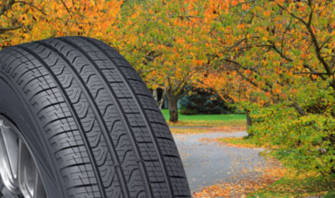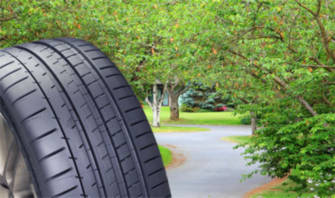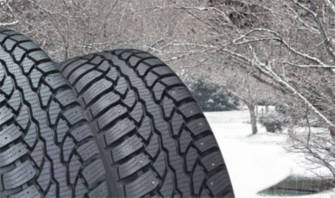Tires are the only point of contact between your vehicle and the road. The differences in tread design and rubber compound construction distinguish types of tires from each other and make a huge difference in how they perform and feel.
It is tempting to ignore the differences and just choose what is cheapest. However, your vehicle will perform better and more safely with the appropriate tires.
All-Season Tires

All-season tires are meant for driving in any weather conditions except significant snow and ice. They are considered an all-around season tire, which is appealing for drivers who don't want to keep switching tire sets between each season. They offer versatility in a variety of weather and road conditions, including very light snow.
Many drivers believe that installing all-season tires will be just fine for year-round driving in all weather conditions. However, this is untrue for many climates throughout the USA. All-season tires sacrifice some wet weather traction to achieve even moderate traction in snow and ice. Additionally, to provide long-lasting tread life, they sacrifice flexibility and grip in cold weather.
Typically, all-season tires do not perform as well as summer or winter tires in wet conditions. They outperform winter tires in dry conditions but do not perform as well as summer tires. All-season tires perform better than summer tires in winter conditions but not nearly as well as winter tires.
Depending on the expected climate and rainfall of where you drive, all-season tires could be a good option for a year-round tire or outside of winter months when temperatures are consistently above 45 degrees. You can check out our top picks for all-season tires or shop our huge catalog.
Summer Tires

Summer tires are designed for responsive performance in both wet and dry driving conditions. It's a common misconception that summer tires are only designed for dry weather but most deliver excellent traction in wet conditions too.
Summer tires feature wide tread and soft compounds, allowing for responsive handling on wet and dry roads. They also typically have deep circumferential grooves to provide wet traction and hydroplaning resistance. Considering how much of the country must tolerate summer storms and rain, summer tires are a good decision for drivers in the warmer months.
Assuming the temperature isn’t too cold, summer tires generally perform better than both winter and all-season tires in wet and dry conditions. For your safety, however, summer tires should not be driven in winter conditions.
Large contact patches and low-profile side walls provide excellent traction and cornering. They often have higher speed ratings. However, because of their soft rubber compound, they wear out faster (compared to all-season tires) and have increased rolling resistance, making them less energy-efficient. With the increased contact patch and lower sidewalls, they can be a little noisy and not as comfortable as other types of tires.
Winter/Snow Tires

Winter tires are designed exclusively for cold weather driving. They have a special rubber tread compound that remains flexible at temperatures below 45 degrees. Their tread patterns feature extra-dense siping for grip in snow and ice, generally without needing to be studded. It's important to make sure you change over to winter tires if your region experiences severe weather during the cold months.
In the past, manufacturers offered "snow tires" that only measured their performance in snow against standard tire designs. The "snow tire" term is no longer used by manufacturers though customers frequently use "winter tires" and "snow tires" interchangeably.
When comparing winter tires to all-season tires, winter tires are far superior when it comes to driving in cold, winter conditions that may include dry, wet, snow, sleet and icy conditions. Summer tires become too stiff in cold weather to provide reliable performance. Likewise, snow tires in summer are just a bad deal. They are so specialized for winter that they do not perform well at all in warm, dry conditions. They will likely wear rapidly and it is recommended that you install summer or all-season tires as soon as the weather is consistently above 45 degrees. Regardless of road conditions, however, once the temp drops below 45 degrees, winter tires provide the most reliable performance over any all-season or summer tire. Check out our top winter tire picks for all budgets.
MORE WINTER/SNOW TIRE INFO
Winter in particular is a heavy and worrisome topic for driving and vehicle maintenance. America's Tire maintains a plethora of useful winter-season knowledge such as tire chains vs tire studs, the 3-Peak Mountain Snowflake designation, all-terrain and mud terrain performance, FAQ and more.
WHICH TIRE IS THE BEST CHOICE FOR ME?
The tire you choose should be based on the climate you live in, the road conditions you typically drive on and finally your individual driving needs. If you experience harsh winters, keeping and changing to a set of winter tires is highly recommended. Changing over to a dedicated set of winter tires is not overly cautious; it is a safety necessity. It also keeps your warm-weather tires from wearing out as quickly.
The same is true if you live in a predominantly warm climate. Summer tires may work best for you if you live and commute in a region that does not experience a true winter. All-season tires might make sense for drivers who live in states between these two extremes.
If you have trouble deciding which option is best for you, turn to Treadwell, our intuitive tire buyer’s guide. Treadwell uses analytical data to find the right fitting tire for your vehicle, driving conditions, style and price point. Our in-store techs use the same buyer’s guide to help you select a tire for you!
Still have questions or need assistance? Just give us a ring, drop by in store or call to make an appointment and we’ll get you taken care of. Get a shorter wait time in-store when you buy and book online!
